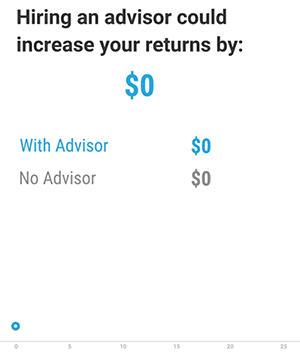




Have you considered the order you'll withdraw your retirement income? Doing so in the incorrect order could cost you hundreds of thousands of dollars.
Choosing a financial advisor is a major life decision that can determine your financial trajectory for years to come.
A 2020 Northwestern Mutual study found that 71% of U.S. adults admit their financial planning needs improvement. However, only 29% of Americans work with a financial advisor.1
The value of working with a financial advisor varies by person and advisors are legally prohibited from promising returns, but research suggests people who work with a financial advisor feel more at ease about their finances and could end up with about 15% more money to spend in retirement.2
A recent Vanguard study found that, on average, a hypothetical $500K investment would grow to over $3.4 million under the care of an advisor over 25 years, whereas the expected value from self-management would be $1.69 million, or 50% less. In other words, an advisor-managed portfolio would average 8% annualized growth over a 25-year period, compared to 5% from a self-managed portfolio.3
SmartAsset’s no-cost tool simplifies the time-consuming process of finding a financial advisor. A short questionnaire helps match you with up to three fiduciary financial advisors each, legally bound to work in your best interest. The whole process takes just a few minutes, and in many cases you can be connected instantly with an advisor for a free retirement consultation.
Smart Financial Tools
The Worst Way to Withdraw From Your Retirement Accounts
Withdrawing from your investments first gives your retirement accounts more time to compound interest. If you dive straight into your 401(k) or IRA, you could cost yourself years worth of income in retirement savings.
Whether you have mutual funds, a brokerage account, ETFs, stocks or bonds, they’re all taxable, so you’ll have to pay capital gains taxes on withdrawals. Some investments also require you to pay taxes on distributions each year, like some mutual funds. Check with a fiduciary financial advisor to see if this is the case for your accounts.
All of the financial advisors on SmartAsset’s matching platform are registered or chartered fiduciaries, who are legally bound to act in your best interest. If your advisor is not a fiduciary and constantly pushes investment products on you, use this no-cost tool to find an advisor who has your best interest in mind.
If you want your maximum Social Security benefits, you’ll need to work until your “full retirement” age. But benefits at age 62, 66 or 67 are not your maximum benefits. The maximum Social Security retirement benefit kicks in at age 70. If you claim before, you're not getting your full entitlement.
Each year after full retirement, your payout increases by a certain percentage based on specific criteria. To maximize on this strategy, we recommend holding off until you are 70 — payments will be the highest possible, increasing by 8% each year you wait.
While this strategy will help you collect the highest Social Security benefit, every situation is different. Consult a financial advisor to figure out how and when Social Security benefits should factor into your unique retirement plan.
You can start withdrawing money from your 401(k) when you turn 59 1/2, but that doesn't mean it's a good idea. The law doesn't require you to start taking Required Minimum Distributions until you turn 72, so this is time your money can keep growing with compound interest.
Put off withdrawing money from your Roth IRA as long as possible. You paid taxes up front so you can take money out of your Roth IRA and it won’t count as taxable income.
Your Roth IRA also will continue to grow tax-free as you tap into your other accounts. Since a Roth IRA holds after-tax funds and the IRS doesn’t need to tax it again, you also don’t need to take Required Minimum Distributions. This account can keep growing for as long as you don't touch it.
Determining the optimal sequence to withdraw money from your retirement accounts is different for everyone, so we recommend speaking with a financial advisor.
Voya Financial found that 79% of people who use an advisor said they “know how to pursue achieving their retirement goals.” The study also found that 59% of those who use an advisor have calculated how much they need to retire, while 52% established a formal retirement investment plan.4
Chances are, there are several highly qualified financial advisors in your town. However, it can seem daunting to choose one. Our no-cost tool makes it easy to find a qualified advisor. You can get matched with up to three fiduciary investment advisors that have been vetted and subject to our due diligence criteria. You even earn a free consultation with each of your matches, so you can compare them and be fully prepared to pick a financial advisor. The entire matching process takes just a few minutes.
SmartAsset Awards & Accolades
Management Solution
2020 FINALIST
Technology Company - NY
FINTECH AWARDS - 2021
for Personal Finance
2019


